Exploring the Dynamics of Wing Surfer Foils
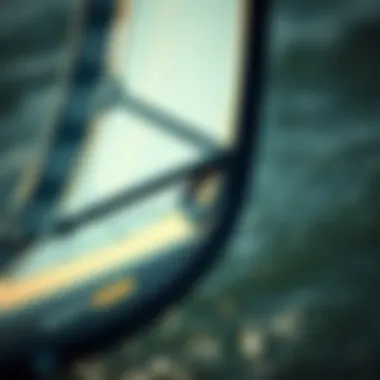
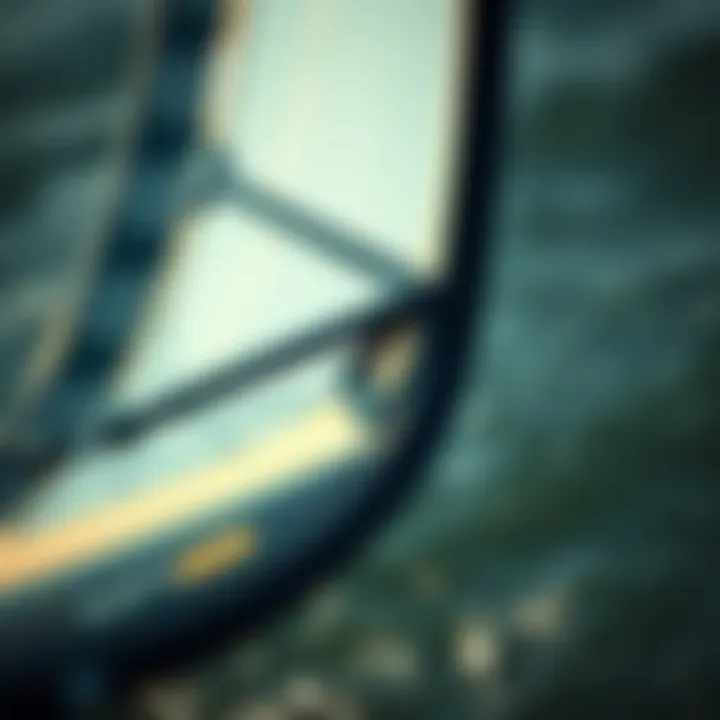
Intro
Wing surfer foils are changing the game in the kiteboarding world, providing new avenues for riders to explore the waters. From innovative designs to various materials used in their construction, these foils bring a unique set of dynamics and experiences to the sport. When equipped with the right foil, riders can enjoy enhanced performance, smoother rides, and greater maneuverability. In this detailed discussion, we will break down the intricacies of wing surfer foils, focusing on key aspects such as gear selection, skill development, and maintenance practices.
No matter if you are a novice learning the ropes or a seasoned kiteboarder seeking an edge, understanding the interplay between your gear and your abilities is crucial. The right setup can not only impact your performance but also your joy in the sport. Let's dive into the essentials of gear selection and how it plays a role in your kiteboarding adventures.
Gear Selection
Selecting the right gear is fundamental to experiencing the most out of wing surfing. The gear can dramatically affect how you perform and enjoy your time on the water. When we speak about gear selection, two primary elements come to the forefront: kites and boards. Understanding each component can streamline your experience and enhance your skills.
Types of Kites
Kites are often the heart of the setup and vary significantly in design and functionality. Here’s a breakdown of commonly found kites:
- Foil Kites: These kites are built for efficiency and provide excellent lift, especially in lighter winds.
- Delta Kites: Known for versatility, delta kites perform well in a variety of conditions and are forgiving for beginners.
- C Kites: These kites provide higher performance, making them perfect for experienced riders, often used for tricks and jumps.
Each kite type brings its own sensitivity to wind conditions. For instance, a foil kite may excel in a light breeze, while a C kite thrives in strong gales. Choosing a kite not only means considering what you want to do on the water but also evaluating the wind patterns typical for your riding area.
Choosing the Right Board
The kiteboard itself is equally crucial as it connects you to the water while giving you the stability or maneuverability needed for different tricks or waves. Here are some common styles of boards:
- Directional Boards: Suited for wave riding, these boards allow for smooth turns and control.
- Twin-Tip Boards: Popular among freestyle riders, they enable you to ride in either direction, offering versatility.
- Foil Boards: Aimed specifically for utilizing foils, they facilitate a unique connection with the water surface and cater to those desiring a different riding experience.
When selecting a board, consider your skill level and the conditions you typically encounter. The right board will match your style while complementing the kite you choose.
Skill Development
Once you have selected the gear, the next step revolves around honing your skills. Skill enhancement is an ongoing journey in kiteboarding that requires practice and patience. Understanding essential techniques can speed up your progression and enjoyment.
Essential Techniques
As a beginner or someone looking to polish their skills, focus on these foundational techniques:
- Body Positioning: Knowing how to position your body correctly can greatly influence your control and balance on the board.
- Edge Control: Mastering how to use the edges of your board effectively will help you cut through water more efficiently.
- Board Recovery: Learning how to recover your board after a fall is crucial; practice getting back on quickly.
Progression Tips
To progress effectively and safely in kiteboarding, here are some tips to consider:
- Practice Regularly: Consistent practice will help reinforce techniques and build muscle memory.
- Seek Guidance: Don’t hesitate to ask for help from instructors or experienced riders. They can demonstrate techniques and provide valuable insights.
- Record Your Sessions: Reviewing footage of your rides can help you pinpoint areas for improvement and celebrate progress.
As you grow in skill, don’t forget that mental preparation and understanding your limits are equally essential.
"The best kitesurfing sessions come when preparation meets opportunity."
Investing time in understanding both the tactical and physical aspects of kiteboarding ensures that your experiences on the water are not only more enjoyable but also safer.
An Prolusion to Wing Surfer Foils
Wing surfer foils are increasingly gaining traction among kiteboarding enthusiasts, serving as a bridge between traditional surfing and the thrill of kiteboarding. Their rise in popularity stems from their unique ability to offer riders an exhilarating experience while efficiently harnessing wind power. Understanding the mechanics and subtleties of wing surfer foils is essential for anyone looking to elevate their kiteboarding game, as these foils extend the possibilities of what can be achieved on the water.
One of the core benefits of wing surfer foils lies in their design, which enables riders to glide smoothly over the water surface while minimizing drag. This advantage makes it easier to maneuver and sustain speed even when the winds are less than favorable. As riders become more engaged with the dynamics of foiling, they often discover a deeper connection with the environment, as the quiet surf and subtle movements create a meditative experience.
Definition and Basic Principles
At its core, a wing surfer foil consists of a wing, mast, and board that work in harmony to lift the rider above the water. When the wind hits the wing, it generates lift, allowing the rider to rise into the air and glide above the surface. This science behind foil dynamics hinges on principles of aerodynamics and hydrodynamics, where the shape of the wing and the angle at which it meets the water play crucial roles in performance.
Foils operate based on Bernoulli's principle, which states that as the speed of a fluid increases, its pressure decreases. In simple terms, this means that as air flows over the curved top of the foil wing, the pressure drops, resulting in lift, while the water underneath the wing experiences higher pressure, pushing the foil upwards. Consequently, riders can experience an almost weightless sensation as they glide across the waves.
History of Wing Surfing
The origins of wing surfing can be traced back to the late 1980s, when early pioneers began experimenting with inflatable wings and foils. The trend was relatively niche for many years, gaining momentum as advancements in materials and technology made them more accessible. Significant milestones included the introduction of dedicated foiling boards and more efficient designs in the early 2000s, which shaped the way riders approached the sport.
In recent years, the popularity of wing surfing has surged, thanks in part to the emergence of performance-driven brands and innovations in design. The shift from traditional kiteboarding to wing foiling reveals a strong communal aspect within the sport, with enthusiasts often sharing knowledge, tips, and experiences to refine their skills. This camaraderie fosters a growing community that thrives on the passion for harnessing wind power and the serenity of gliding on water.
Design Elements of Wing Surfer Foils
The design of wing surfer foils is at the heart of their functionality and effectiveness in delivering an extraordinary riding experience. Understanding these design elements is paramount for kiteboarders and enthusiasts alike, as it directly affects performance, stability, and maneuverability on the water. The choice of materials, the shape and structure of the foils, and the variation in wing sizes all harmonize to create a foil that suits various riding styles and environmental conditions.
Material Composition
When it comes to foiling, the materials used in their construction largely determine durability and performance. Most foils are made from materials like carbon fiber, alloy, or a hybrid blend that combines both.
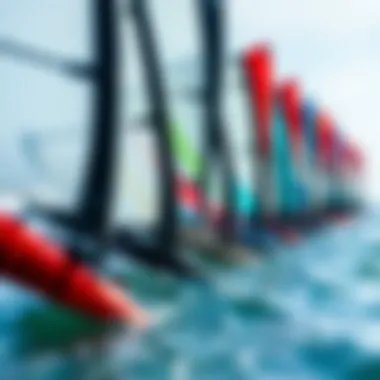
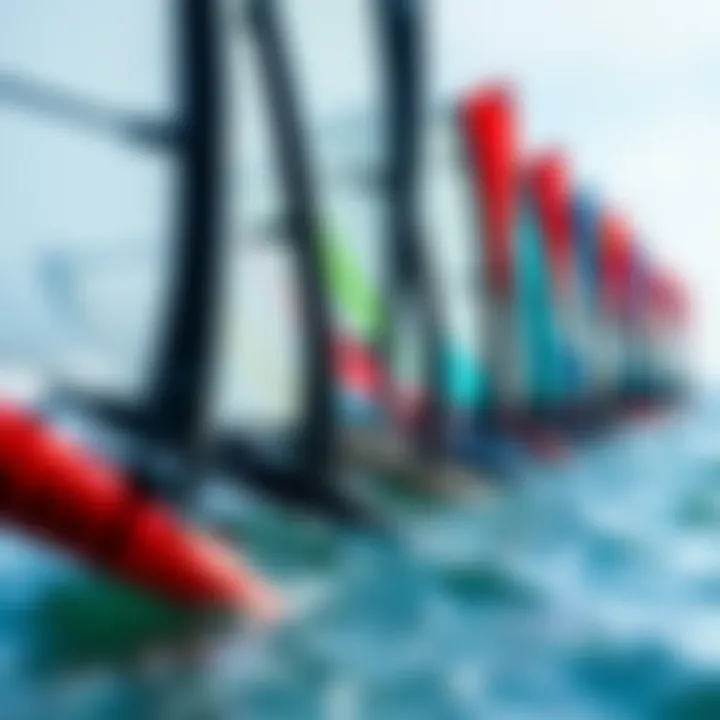
- Carbon Fiber: Known for its lightweight yet strong properties, carbon fiber is favored by many advanced riders who seek speed and agility. This material allows for a delicate balance between stiffness and flexibility, enabling sharp turns and rapid acceleration.
- Aluminum Alloys: Typically less costly, aluminum alloys are heavier but provide robustness and stability, making them a common choice for beginners and casual riders. They offer a more forgiving ride while providing sufficient buoyancy.
- Hybrid Designs: Some foils utilize a combination of materials to optimize weight and performance, appealing to riders who want a bit of everything.
Selecting the right material is not just about preference; it shapes how the foil interacts with water, influencing lift, drag, and overall efficiency in diverse conditions.
Shape and Structure
The shape of a foil is a crucial factor that impacts various aspects of riding. Foils generally come in three primary shapes: high aspect, low aspect, and medium aspect foils. Each one has characteristics tailored to different styles of riding:
- High Aspect Foils: Characterized by a longer wingspan relative to the width, these foils are designed for speed. They cut through water with less resistance, making them ideal for speed enthusiasts who aim to ride in lighter winds.
- Low Aspect Foils: Shorter and wider, low aspect designs provide increased stability and lift, making them suitable for beginners or those riding in choppy waters. They allow for easier control and a more stable ride during turbulent conditions.
- Medium Aspect Foils: These serve as a middle ground, offering a balance of speed and stability. They cater to intermediate riders looking for versatility as they transition between different skill levels.
The structure of the foil also warrants attention, with considerations including fuselage length and wing profile. A longer fuselage tends to enhance stability, while the wing profile affects how smoothly the foil glides over the water.
Wing Sizes and Their Impact
Selecting the right wing size is akin to choosing the right surfboard — it fundamentally alters your ride experience. Wings vary in size, and each dimension brings along specific advantages:
- Larger Wings: These provide lift at lower speeds and are better suited for light wind days, enabling riders to get on the water when winds are not at their strongest. However, larger wings can be cumbersome in high winds and may hinder maneuverability.
- Smaller Wings: These are designed for speed and control in high winds, allowing advanced riders to carve through the water deftly. The trade-off, though, is that smaller wings require more speed to generate lift, which may not be conducive for novices still mastering balance.
Choosing wing sizes should reflect personal riding goals as well as local environmental factors. For instance, a rider in consistently windy coastal environments might opt for a smaller wing, while someone in a lighter wind zone would benefit from a larger setup.
"The design of your wing surfer foil is not just a matter of aesthetics; it's about creating a synergy between rider and water, amplifying the thrill of kiteboarding."
Understanding these design nuances enables kiteboarders to make informed decisions that enhance their performance on the water, ensuring an exhilarating experience whether they're just starting or looking to push their boundaries.
Types of Wing Surfer Foils
Understanding the types of wing surfer foils is fundamental for anyone looking to elevate their kiteboarding experience. Selecting the right foil impacts not just performance but also the enjoyment and safety of the ride. Each type of foil comes with its unique characteristics, catering to different skill levels and riding styles. Here, we will explore three primary categories: beginning foils, advanced foils, and specialty foils, providing critical insights into their usage.
Beginning Foils
Beginning foils are designed with novices in mind, focusing on stability and ease of use. Their wider wingspan and larger surface area allow for increased lift, helping new riders get off the water with minimal effort. Typically, these foils facilitate a softer landing and smoother ride, which is crucial for someone still getting the hang of wing surfing.
- Key features include:
- Stabilized Design: Wider wings provide a larger platform, making it easy to balance.
- Lower Speed Requirements: Allowing beginners to ride comfortably even in lighter winds.
- Durability: Built to withstand the bumps and scrapes that come with learning.
New riders often experience anxiety in the early stages; thus, a reliable beginning foil can be an excellent safety net. Investing in a quality beginner foil sets the foundation for more advanced maneuvers in future.
Advanced Foils
For those who have considered themselves intermediate or are seeking to push their boundaries, advanced foils represent a leap in performance and agility. These foils are characterized by their sleek, narrow designs, which allow for quicker turns and better speed. Riders familiar with the basic dynamics of foiling find these higher-performance foils enhance their skillset.
- Notable attributes include:
- Performance-Oriented: Designed for speed and precision, catering to skilled riders.
- Responsive Control: Enhanced maneuverability facilitates dynamic riding styles.
- Variety of Shapes: Tailored to specific conditions or goals, such as racing or trick riding.
As they develop control, riders using advanced foils can experiment with tricks and jumps, elevating their overall kiteboarding enjoyment. This shift allows them to experience the thrill of higher speeds and refined techniques that a less forgiving foil might not allow.
Specialty Foils
Specialty foils address niche needs within the kiteboarding community. These can often include designs tailored for specific conditions, like waves or flat water. While they might not be as versatile as beginner or advanced foils, they can greatly enhance specific aspects of a rider's experience.
- Common types of specialty foils:
- Wave Foils: Ideal for riding in ocean swells, they offer a unique way to harness wave energy.
- Freestyle Foils: Designed for those focusing on tricks and aerial maneuvers, built to respond instantly to pressure changes.
- Race Foils: Often have ultra-thin profiles, engineered for maximum speed on flat water courses.
Choosing the right specialty foil can be a huge part of enhancing performance in specific situations. For example, a wave foil can provide a distinct riding experience compared to an all-around design. Exploring these unique options allows enthusiasts to find their unique niche in the kiteboarding realm.
Benefits of Using Foils in Kiteboarding
Kiteboarding has always been a sport that embraces innovation. One of the most game-changing advancements in recent years is the introduction of wing surfer foils. These devices not only add a unique element to the sport but also significantly enhance the overall riding experience. Let’s delve into some of the key benefits that using foils can bring to kiteboarding, including improved performance, increased speed, and the ability to ride in light winds.
Enhanced Performance
The performance of a kiteboard depends on a variety of factors, and foils play a crucial role in refining these aspects. A well-designed foil helps to lift the rider above the water, effectively reducing drag. This enables a kiteboarder to achieve smoother transitions and more stable rides.
- Foil Lift: With the right foil, riders can tap into the natural lift created by the foil’s shape. This lift allows kiteboarders to ride with less effort, making it easier to maintain control and balance.
- Improved Maneuverability: Foils create the opportunity for sharper turns and spins, which can come in handy during freestyle tricks. Riders notice noticeable improvements in their agility while cutting through water.
- Consistency in Performance: As most riders know, the water conditions can vary significantly from one outing to another. Foils perform reliably across different conditions, offering stable lifts even when the wind isn't ideal. This consistency helps boost confidence in riders, promoting better skill development.
"The thrill of gliding above the water is unlike anything else. Foils empower riders to connect more dynamically with their environment."
Increased Speed
Another crucial advantage of wing surfer foils is their ability to promote greater speeds on the water. The physics behind this is quite fascinating. The foil essentially reduces water friction, thus allowing for quick acceleration.
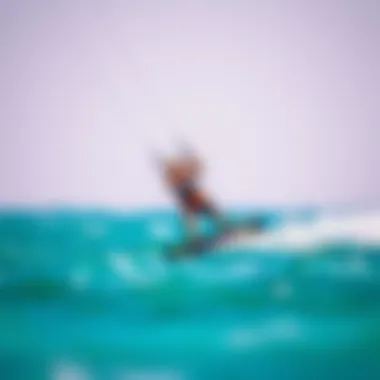
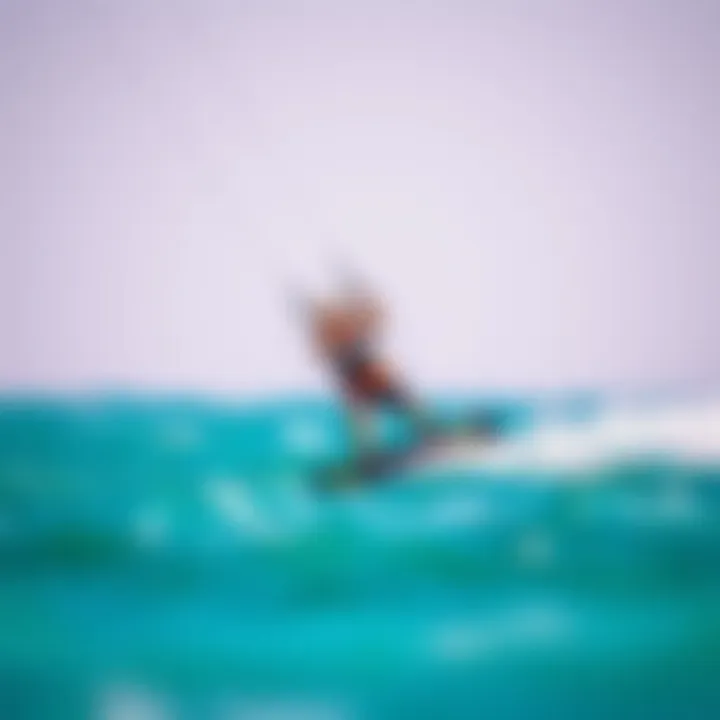
- Hydrodynamic Efficiency: Modern foils are engineered with hydrodynamics in mind, cutting through water with minimal resistance. This design translates into less energy spent to attain higher speeds.
- Power Management: When a rider harnesses the wind well, the foil assists in translating that power into forward motion. Increased speed doesn't just feel exhilarating; it opens the door to exploring more challenging conditions or simply enjoying an extended ride.
Ability to Ride in Light Winds
One of the hallmarks of foils is their ability to function efficiently in low wind conditions. This characteristic opens up an entirely new realm for kiteboarders who may have felt limited previously.
- Minimum Wind Requirements: Unlike traditional setups that often require a robust wind to get going, foils enable riders to enjoy kiteboarding even when winds are light. This versatility means more days on the water regardless of weather conditions.
- Sailing Sensation: Riding on a foil in lighter winds creates a unique sensation, akin to sailing. Riders often find that they can cover impressive distances with just a gentle breeze, making the sport accessible to those who might have shied away from it before.
Choosing the Right Foil for Your Needs
Choosing the right foil for your wing surfing journey is a fundamental step that can dramatically enhance your riding experience. Whether you're just starting out or you're a seasoned pro, the right foil will make a significant difference in your performance, control, and overall enjoyment on the water. In this section, we’ll explore three key elements to consider: assessing skill levels, environmental conditions, and riding style preferences.
Assessing Skill Levels
Before diving into the various types of foils available on the market, it’s crucial to honestly evaluate your own skill level. For beginners, starting with a more stable and forgiving foil design is often recommended. These foils typically have larger surface areas and lower aspect ratios, making them easier to control and less prone to allowing a loss of balance.
On the other hand, advanced riders may prefer high-performance foils that are sleek and nimble. Such foils allow for sharper turns, greater speeds, and more advanced techniques like jumping and tricks. A good rule of thumb is that the more skillful you are, the more specialized your foil can be. Keep your own limits in mind and choose wisely to ensure that your equipment matches your capabilities.
Environmental Conditions
Different riding environments will influence which foil works best. If you often find yourself riding in shallow waters or over reef, you’ll want a foil that has a shorter mast length which is easier to maneuver. Conversely, in deeper waters, a longer mast can provide better clearance and thus greater performance due to its ability to maintain lift.
Wind conditions also play a vital role. For light wind days, larger foils provide more lift and easier take-off, helping you stay afloat. On the flip side, if you're riding in high winds, a smaller, more compact foil helps you cut through the gusts with stability and speed.
Ultimately, match your foil choice with the typical conditions you’ll face to have a more enjoyable ride.
Riding Style Preferences
Finally, personal riding style has a huge impact on your foil choice. Do you prefer mellow cruising or more aggressive maneuvers? For those who lean toward leisure and exploration, a larger, more durable foil is ideal. This setup allows for comfortable rides and the ability to glide smoothly over waves.
If you're the adventurous type, looking to perform tricks and fast turns, you might opt for a lightweight, high-aspect ratio foil. These designs are snappy and responsive, perfect for carving tight turns and catching air. It’s about knowing your own inclinations in the sport and going with what feels natural to you.
Key takeaway: Our choice of foil greatly influences our riding quality. Assess skill, match environmental conditions, and align with riding style for the ultimate experience.
By considering these elements carefully, you set the stage for an enjoyable and fulfilling wing surfing experience. Remember, the right foil isn’t just a piece of gear; it’s a pivotal factor in shaping your relationship with the water.
Safety Practices in Wing Surfing
When it comes to wing surfing, safety shouldn’t just be an afterthought— it’s the name of the game. Understanding safety practices serves a dual purpose: it not only shields the rider from potential dangers but also enhances the overall experience. Regardless of skill levels, the thrill of riding on foils comes with certain risks, making it essential to be educated about both foil dynamics and the necessary safety gear.
Understanding Foil Dynamics
The dynamics of wing foiling hinge on the balance between lift, drag, and stability. Each foil’s design varies, influencing how it interacts with water and air. When the wind hits the wing, it creates lift. However, if the rider isn't aware of how that lift functions, things can go south quickly. The craft can easily overpower the user, leading to an unexpected crash or a fall.
Riders need to grasp two pivotal concepts:
- Lift and Drag: Lift propels the rider out of the water, while drag tries to pull them back down. The trick lies in finding that sweet spot where lift is maximized without encountering excessive drag.
- Speed Control: As riders gain momentum, they can drift up and over the water. But too much speed could lead to a loss of control. Keeping speed in check is crucial, especially for beginners who might not yet have the feel of the foil.
"It’s easy to get swept up in the excitement, but keeping foils leveled and knowing how they react to both wind and water can make all the difference between a ride to remember and a painful tumbler."
In essence, understanding foil dynamics allows riders to anticipate their movements better and react swiftly to changing conditions. This knowledge arms them with the tools to navigate tricky situations, making it an invaluable part of their safety training.
Essential Safety Gear
Equipping oneself with the right safety gear is akin to donning armor before a battle. Proper gear doesn’t just safeguard against falls; it builds confidence, empowering riders to push their limits.
Some essential gear includes:
- Personal Flotation Device (PFD): A properly fitted PFD ensures that a rider stays buoyant should they fall or get knocked out. It's a basic yet lifesaving piece of equipment.
- Helmet: Protecting the noggin is paramount. A quality helmet can protect from impacts, should the unexpected happen, or should the rider miscalculate a maneuver.
- Impact Vest: This adds another layer of cushioning in case of falls, especially when flying high above water. It also provides additional support for the core, helping with balance.
- Leash: Keeping the wing connected prevents it from drifting away and ensures the rider can quickly regain control after a fall.
- Footwear: Non-slip shoes with good grip can significantly help with stability on the board.
The right combination of these items fosters a safer environment for the kiteboarding enthusiast. While it might seem inconvenient at times, especially in warmer weather, each piece of gear plays a distinct role in preserving safety.
Ultimately, safety practices in wing surfing encapsulate both theoretical knowledge and physical preparation. Gaining a solid understanding of foil dynamics paired with the right safety gear can enhance not just the safety of the ride, but also the enjoyment and confidence that come with mastering wing surfing.
Maintenance and Care for Foils
Caring for your wing surfer foil is not just a matter of aesthetics; it directly influences performance, longevity, and safety. When you take the time to maintain your foil, you're investing in not only a better ride but also in the overall safety and reliability of your equipment. Regular maintenance can keep your foil in peak condition, ensuring that it performs at its best, whether you’re shredding waves or cruising along smooth waters.
Cleaning and Inspection
Cleaning your foil should become routine after each session. Saltwater and sand can compromise the integrity of your foil over time, leading to corrosion and other unwanted wear. Here are some steps to take:
- Rinse with Freshwater: After every outing, rinse your foil down with fresh water to remove salt and sand. Pay special attention to the connection points and the underside, where debris tends to gather.
- Drying: After rinsing, ensure the foil is completely dry before storing it. Moisture can foster rust or mold, especially on screws and metal parts.
- Visual Inspection: Check for any signs of damage, like scratches or dents. Inspect the wings and mast for any hairline fractures that could worsen over time.
- Bolts and Connections: Periodically check that all bolts are tight. Loose bolts can lead to misalignment, impacting performance.
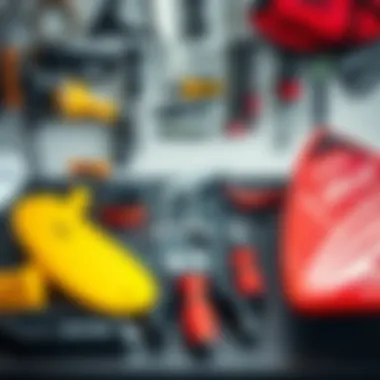
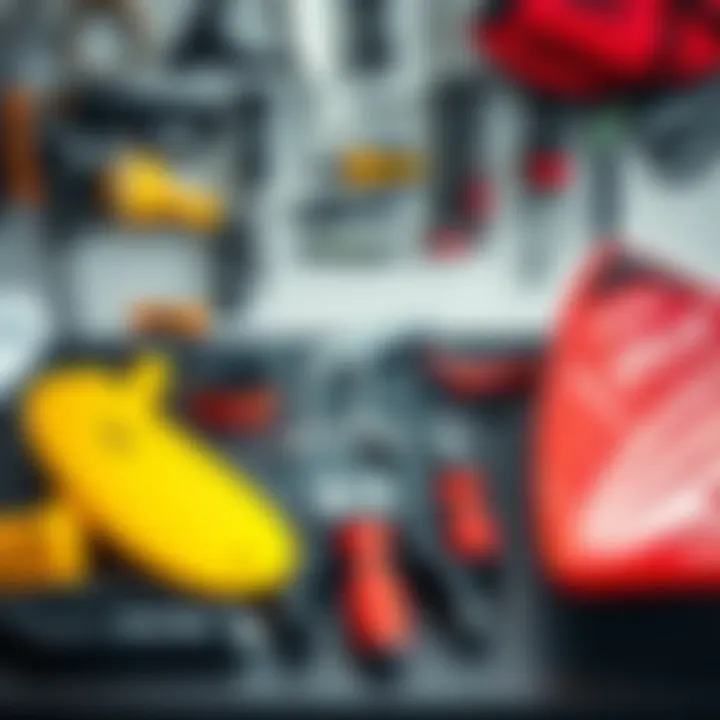
By keeping your foil clean and inspecting it regularly, you're likely to catch potential issues early, which can save time and money in repairs down the road.
Repairs and Upkeep
Like any piece of equipment, wing surfer foils may require repairs or maintenance over time. Here’s how to approach that situation responsibly and effectively:
- Small Repairs: For minor scratches or chips, consider using epoxy resin to fill in gaps. A repair kit specific to your foil material may come in handy. This can maintain smooth airflow over the surface, preserving performance.
- Professional Help: For structural issues or significant damage, it’s best to consult a professional. An expert can assess damage that you might overlook and ensure your foil is safe and functional.
- Regular Check-Ups: To keep everything in top shape, dedicate time to check the hardware on a monthly basis. Look at screws, wings, and the mast. Ensure everything feels stable and shows no signs of wear.
- Protective Cover: When not in use, store your foil in a protective cover to shield it from UV rays and physical damage. This can go a long way in preserving its lifespan and maintaining its cosmetic appeal.
Proper upkeep of your foil not only enhances its performance but also promotes safety in your riding experience.
In a nutshell, understanding maintenance and care for your wing surfer foil is essential for any dedicated kiteboarder. It merges craftsmanship with personal responsibility, allowing you to maximize your riding experience and lengthen the life of your beloved gear.
Environmental Impact of Foiling
The intersection of adventure sports and environmental stewardship is more critical now than ever. Foiling, while an exhilarating pastime, poses questions about its effect on marine ecosystems. Understanding the environmental impact of foiling not only informs riders about their choices but also equips them to make responsible decisions that enhance their riding experiences while protecting nature.
Ecosystem Considerations
The wildlife and marine habitats where we ride speak to the essence of our sport. When planning a foiling session, it’s essential to be mindful of the delicate balance of the ecosystem.
- Disturbance to Wildlife: Foiling can disturb local wildlife, especially during breeding seasons. Areas with high bird or marine mammals’ activity can be sensitive. Riders should be aware of nesting sites and avoid these areas to prevent undue stress on animals.
- Underwater Ecosystems: Foils interact with underwater structures and wildlife, which can lead to erosion or damage to coral reefs. Familiarizing oneself with the local terrain and avoiding shallow parts can mitigate these impacts. Travelling in groups can also help reduce the footprint left in sensitive areas.
Increased awareness and education about local ecosystems can foster a sense of responsibility among riders, strengthening the relationship between foiling and environmental conservation. Joining initiatives or local conservation efforts can also amplify a rider's positive impact on ecosystems.
Sustainable Practices for Riders
Navigating the balance between enjoyment and environmental consciousness requires riders to adopt sustainable practices. Making adjustments to our foiling lifestyles helps minimize the negative footprint we leave behind.
- Choosing Eco-Friendly Gear: Riders can opt for equipment made from sustainable materials. Investing in brands that prioritize environmental impact can ensure that our enjoyment doesn't come at a cost to nature.
- Leave No Trace: Adherence to this principle can significantly reduces the environmental footprint while out on the water. This includes carrying out all waste and respecting the surroundings, ensuring not to litter the pristine environments where we ride.
- Ride During Off-Peak Times: Scheduling outings when there are fewer people can lessen disruption to wildlife and decrease crowd-related stress on fragile ecosystems.
- Participate in Clean-Up Efforts: Engaging in beach clean-ups creates a direct positive impact. It’s a chance to unite with fellow enthusiasts and showcase camaraderie while caring for the oceans we love to ride.
"The oceans are a gift; we must honor their majesty through careful stewardship while we pursue our passions."
Adopting these sustainable practices doesn’t just contribute to a better environment; it enriches the experience of riding by fostering a deeper connection with the natural world. The dance of the foil above the water should be as harmonious with nature as it is thrilling to the rider.
Future Trends in Wing Surfing
As the sport of wing surfing gains traction globally, it’s essential to keep an eye on the ever-evolving landscape. This section focuses on the future trends in wing surfing, exploring the technological innovations shaping the sport and the new riding styles emerging as riders push the boundaries. Understanding these developments is crucial for kiteboarders, instructors, and enthusiasts who seek to stay ahead of the curve and improve their performance in various conditions.
Technological Innovations
The future of wing surfing is undeniably linked to technological advancements that continuously enhance equipment performance. From materials to designs, innovation is a driving force. For instance, the advent of lighter, stronger materials like carbon fiber and advanced composites is revolutionizing the way foils are made. These materials not only reduce weight but also increase responsiveness and durability.
Cutting-edge hydrodynamic designs are also emerging, tapping into advanced physics to optimize lift and minimize drag. Riders can expect foils that are more efficient in lower winds, allowing them to glide effortlessly over water. Moreover, integrated sensors and smart technology are becoming commonplace. Imagine a foil equipped with sensors that provide real-time feedback on performance metrics—this can pretty much change how kiteboarders approach their technique.
Riders might also see an introduction of customizable settings in their gear, where they can adjust the stiffness and flexibility based on wind conditions or personal preference. This level of customization can lead to a tailored riding experience, allowing individuals to fully harness their skills and adapt to changing environments seamlessly.
Evolving Riding Styles
Alongside technological changes, the riding styles in wing surfing are evolving too. As more athletes take to the water, they bring with them different backgrounds and influences, leading to the fusion of techniques. What this means is we can expect a departure from traditional riding styles towards more dynamic and creative forms of expression.
For example, the influence of freestyle kiteboarding is evident in how wing surfers are experimenting with greater aerial maneuvers and tricks, incorporating flips and spins that were once exclusive to kiteboarding. Surfers are beginning to merge the fluidity of traditional surfing with the stability provided by foils. With this shift, riders are finding unique ways to interact with the elements, pushing not only their limits but also reimagining what wing surfing can be.
In addition, the growing popularity of downwind foiling is reshaping riding patterns. This style encourages longer distances and enables surfers to harness ocean swells, giving rise to more adventurous riding experiences. It also promotes environmental awareness, as downwinders tend to prioritize natural setups and try to minimize their impact on delicate ecosystems.
Ultimately, embracing these future trends not only keeps riders competitive but also bolsters the community’s sustainability efforts.
As the boundaries of wing surfing continue to expand, keeping abreast of these innovative developments will undoubtedly provide participants with the tools to enhance their riding experience and contribute positively to the sport. Whether it’s through the application of cutting-edge technology or the exploration of emerging riding styles, the future looks bright for wing surfing enthusiasts.
The End
In the world of wing surfing, understanding the intricacies of wing surfer foils is crucial to elevating one's experience on the water. The nuances involved in selecting the proper foil cannot be overstated. It fundamentally influences performance, handling, and enjoyment during sessions on the water.
Recap of Key Insights
Throughout this article, several key points have emerged:
- Definition and Fundamentals: Foils create lift in a unique manner, allowing riders to glide effortlessly over the water surface, rather than skimming directly on it.
- Design Significance: Key design elements such as shape, size, and materials impact performance characteristics dramatically. Choosing a foil tailored to personal needs can enhance speed and control multi-fold.
- Diverse Types: There’s no one-size-fits-all when it comes to foils. Whether for beginners, advanced riders, or specialized conditions, understanding the type of foil that aligns with one’s riding style is vital.
- Safety Practices: Recognizing the dynamics of foiling and maintaining essential safety gear ensures a enjoyable and responsible riding experience.
- Environmental Responsibility: Engaging with nature can have consequences; thus, sustainable practices are pivotal in preserving water ecosystems while enjoying the sport.
By synthesizing these insights, riders can make informed decisions that enrich their kiteboarding adventures, enabling a deeper connection with the sport. It’s essential not to shortcut this learning process; understanding the foils can vastly improve not just performance but also the joy of the ride.
Encouraging Responsible Participation
The essence of participating in wing surfing goes beyond just mastering the mechanics of foils. It's about developing a holistic approach to riding that encompasses safety, environmental awareness, and community engagement. Riders should actively partake in ensuring their practices don't harm the water ecosystems they cherish.
Some approaches to encourage responsible participation include:
- Education Initiatives: Join courses or workshops focusing on safe riding and environmental practices. Knowledge equips riders with the skills to make sound decisions on the water.
- Community Involvement: Engage with local kiteboarding communities to share best practices and experiences. A united front fostering responsibility can effectively spread positive behaviors among enthusiasts.
- Sustainable Equipment Choices: Opt for brands and products that prioritize eco-friendly materials and manufacturing processes. This choice does not only impact performance but supports sustainability efforts in the sport.
- Respecting Natural Habitats: Always be conscious of local wildlife and habitats, avoiding areas of significance, especially during breeding seasons.
By fostering a culture of responsibility among kiteboarders, the sport can thrive while minimizing its impact on the environment. This comprehensive exploration of wing surfer foils serves as a foundation—now it's up to every individual to take these insights and apply them on the water, becoming not just better riders, but more conscientious participants in the aquatic world.















